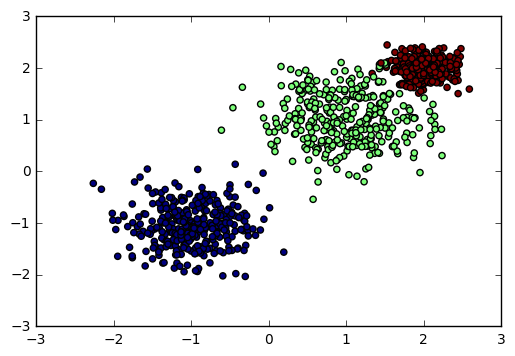在学习机器学习算法的过程中,我们经常需要数据来验证算法,调试参数。但是找到一组十分合适某种特定算法类型的数据样本却不那么容易。还好numpy, scikit-learn都提供了随机数据生成的功能,我们可以自己生成适合某一种模型的数据,用随机数据来做清洗,归一化,转换,然后选择模型与算法做拟合和预测。下面对scikit-learn和numpy生成数据样本的方法做一个总结。
1. numpy随机数据生成API
numpy比较适合用来生产一些简单的抽样数据。API都在random类中,常见的API有:
1) rand(d0, d1, …, dn) 用来生成d0xd1x…dn维的数组。数组的值在[0,1]之间
例如:np.random.rand(3,2,2),输出如下3x2x2的数组
array([[[ 0.49042678, 0.60643763],
[ 0.18370487, 0.10836908]],
[[ 0.38269728, 0.66130293],
[ 0.5775944 , 0.52354981]],
[[ 0.71705929, 0.89453574],
[ 0.36245334, 0.37545211]]])
2) randn((d0, d1, …, dn), 也是用来生成d0xd1x…dn维的数组。不过数组的值服从N(0,1)的标准正态分布。
例如:np.random.randn(3,2),输出如下3x2的数组,这些值是N(0,1)的抽样数据。
array([[-0.5889483 , -0.34054626],
[-2.03094528, -0.21205145],
[-0.20804811, -0.97289898]])
如果需要服从N(μ,σ2)’>N(μ,σ2)N(μ,σ2)即可,例如:
例如:2*np.random.randn(3,2) + 1,输出如下3x2的数组,这些值是N(1,4)的抽样数据。
array([[ 2.32910328, -0.677016 ],
[-0.09049511, 1.04687598],
[ 2.13493001, 3.30025852]])
3)randint(low[, high, size]),生成随机的大小为size的数据,size可以为整数,为矩阵维数,或者张量的维数。值位于半开区间 [low, high)。
例如:np.random.randint(3, size=[2,3,4])返回维数维2x3x4的数据。取值范围为最大值为3的整数。
array([[[2, 1, 2, 1],
[0, 1, 2, 1],
[2, 1, 0, 2]],
[[0, 1, 0, 0],
[1, 1, 2, 1],
[1, 0, 1, 2]]])
再比如: np.random.randint(3, 6, size=[2,3]) 返回维数为2x3的数据。取值范围为[3,6).
array([[4, 5, 3],
[3, 4, 5]])
4) random_integers(low[, high, size]),和上面的randint类似,区别在与取值范围是闭区间[low, high]。
5) random_sample([size]), 返回随机的浮点数,在半开区间 [0.0, 1.0)。如果是其他区间[a,b),可以加以转换(b - a) * random_sample([size]) + a
例如: (5-2)*np.random.random_sample(3)+2 返回[2,5)之间的3个随机数。
array([ 2.87037573, 4.33790491, 2.1662832 ])
2. scikit-learn随机数据生成API介绍
scikit-learn生成随机数据的API都在datasets类之中,和numpy比起来,可以用来生成适合特定机器学习模型的数据。常用的API有:
1) 用make_regression 生成回归模型的数据
2) 用make_hastie_10_2,make_classification或者make_multilabel_classification生成分类模型数据
3) 用make_blobs生成聚类模型数据
4) 用make_gaussian_quantiles生成分组多维正态分布的数据
3. scikit-learn随机数据生成实例
3.1 回归模型随机数据
这里我们使用make_regression生成回归模型数据。几个关键参数有n_samples(生成样本数), n_features(样本特征数),noise(样本随机噪音)和coef(是否返回回归系数)。例子代码如下:
import numpy as np import matplotlib.pyplot as plt %matplotlib inline from sklearn.datasets.samples_generator import make_regression # X为样本特征,y为样本输出, coef为回归系数,共1000个样本,每个样本1个特征 X, y, coef =make_regression(n_samples=1000, n_features=1,noise=10, coef=True) # 画图 plt.scatter(X, y, color='black') plt.plot(X, X*coef, color='blue', linewidth=3) plt.xticks(()) plt.yticks(()) plt.show()
输出的图如下:
3.2 分类模型随机数据
这里我们用make_classification生成三元分类模型数据。几个关键参数有n_samples(生成样本数), n_features(样本特征数), n_redundant(冗余特征数)和n_classes(输出的类别数),例子代码如下:
import numpy as np import matplotlib.pyplot as plt %matplotlib inline from sklearn.datasets.samples_generator import make_classification # X1为样本特征,Y1为样本类别输出, 共400个样本,每个样本2个特征,输出有3个类别,没有冗余特征,每个类别一个簇 X1, Y1 = make_classification(n_samples=400, n_features=2, n_redundant=0, n_clusters_per_class=1, n_classes=3) plt.scatter(X1[:, 0], X1[:, 1], marker='o', c=Y1) plt.show()
输出的图如下:

3.3 聚类模型随机数据
这里我们用make_blobs生成聚类模型数据。几个关键参数有n_samples(生成样本数), n_features(样本特征数),centers(簇中心的个数或者自定义的簇中心)和cluster_std(簇数据方差,代表簇的聚合程度)。例子如下:
import numpy as np import matplotlib.pyplot as plt %matplotlib inline from sklearn.datasets.samples_generator import make_blobs # X为样本特征,Y为样本簇类别, 共1000个样本,每个样本2个特征,共3个簇,簇中心在[-1,-1], [1,1], [2,2], 簇方差分别为[0.4, 0.5, 0.2] X, y = make_blobs(n_samples=1000, n_features=2, centers=[[-1,-1], [1,1], [2,2]], cluster_std=[0.4, 0.5, 0.2]) plt.scatter(X[:, 0], X[:, 1], marker='o', c=y) plt.show()
输出的图如下:

3.4 分组正态分布混合数据
我们用make_gaussian_quantiles生成分组多维正态分布的数据。几个关键参数有n_samples(生成样本数), n_features(正态分布的维数),mean(特征均值), cov(样本协方差的系数), n_classes(数据在正态分布中按分位数分配的组数)。 例子如下:
import numpy as np import matplotlib.pyplot as plt %matplotlib inline from sklearn.datasets import make_gaussian_quantiles #生成2维正态分布,生成的数据按分位数分成3组,1000个样本,2个样本特征均值为1和2,协方差系数为2 X1, Y1 = make_gaussian_quantiles(n_samples=1000, n_features=2, n_classes=3, mean=[1,2],cov=2) plt.scatter(X1[:, 0], X1[:, 1], marker='o', c=Y1)
输出图如下
2. plot 画图相关
在matplotlib中,整个图像为一个Figure对象。在Figure对象中可以包含一个或者多个Axes对象。每个Axes(ax)对象都是一个拥有自己坐标系统的绘图区域。在pyplot中,画纸的概念对应的就是Axes/Subplot。
plt.subplot(221) # 第一行的左图
plt.subplot(222) # 第一行的右图
plt.subplot(212) # 第二整行
plt.show()3. 降维
可以将流形学习方法分为线性的和非线性的两种,线性的流形学习方法如我们熟知的主成份分析(PCA),非线性的流形学习方法如等距映射(Isomap)、拉普拉斯特征映射(Laplacian eigenmaps,LE)、局部线性嵌入(Locally-linear embedding,LLE)。一图概括所有。

t-SNE算是比较新的一种方法,也是效果比较好的一种方法.该方法是流形(非线性)数据降维的经典,从发表至今鲜有新的降维方法能全面超越。该方法相比PCA等线性方法能有效将数据投影到低维空间并保持严格的分割界面;缺点是计算复杂度大,一般推荐先线性降维然后再用tSNE降维.
4.:使用K-Means算法检测DGA域名
1..数据搜集和数据清洗 加载alexa前100的域名作为白样本,标记为0;分别加载cryptolocker 和post-tovar-goz家族的DGA域名,分别标记为2和3:
x1_domain_list = load_alexa("../data/dga/top-100.csv")
x2_domain_list = load_dga("../data/dga/dga-cryptolocke-50.txt")
x3_domain_list = load_dga("../data/dga/dga-post-tovar-goz-50.txt")
x_domain_list=np.concatenate((x1_domain_list, x2_domain_list,x3_domain_list))
y1=[0]*len(x1_domain_list)
y2=[1]*len(x2_domain_list)
y3=[2]*len(x3_domain_list)
y=np.concatenate((y1, y2,y3))
```
####2.特征化
以2-gram分隔域名,切割单元为字符,以整个数据集合的2-gram结 果作为词汇表并进行映射,得到特征化的向量:
2-gram分词
cv = CountVectorizer(ngram_range=(2, 2), decode_error=”ignore”, token_pattern=r”\w”, min_df=1)
x= cv.fit_transform(x_domain_list).toarray()
2-gram分词也是一种最大概率分词,只不过在计算一个词概率的时候,它不光考虑自己,还会考虑它的前驱。
我们需要两个字典。第一个字典记录词wi
出现的频次,第二个字典记录词对儿<wj,wi>共同出现的频次。有这两份字典,我们就可以计算出条件概率p(wi|wj)=p(wi,wj)/p(wj)
####3.训练样本 实例化K-Means算法:
model=KMeans(n_clusters=2, random_state=random_state)
y_pred = model.fit_predict(x)
#####4.效果验证 使用TSNE将高维向量降维,便于作图:
tsne = TSNE(learning_rate=100)
x=tsne.fit_transform(x)
可视化聚类效果(见图10-5),其中DGA域名使用符号“×”标识:
for i,label in enumerate(x):
x1,x2=x[i] if y_pred[i] == 1:
else:
lt.scatter(x1, x2,marker='x')
plt.show()
总的代码
# -*- coding:utf-8 -*-
import sys
import re
import numpy as np
from sklearn.externals import joblib
import csv
import matplotlib.pyplot as plt
import os
from sklearn.feature_extraction.text import CountVectorizer
from sklearn import cross_validation
import os
from sklearn.naive_bayes import GaussianNB
from sklearn.cluster import KMeans
from sklearn.manifold import TSNE
#####3处理域名的最小长度
MIN_LEN=10
##########随机程度
random_state = 170
def load_alexa(filename):
domain_list=[]
csv_reader = csv.reader(open(filename))
for row in csv_reader:
domain=row[1]
if domain >= MIN_LEN:
domain_list.append(domain)
return domain_list
def domain2ver(domain):
ver=[]
for i in range(0,len(domain)):
ver.append([ord(domain[i])])
return ver
def load_dga(filename):
domain_list=[]
#xsxqeadsbgvpdke.co.uk,Domain used by Cryptolocker - Flashback DGA for 13 Apr 2017,2017-04-13,
# http://osint.bambenekconsulting.com/manual/cl.txt
with open(filename) as f:
for line in f:
domain=line.split(",")[0]
if domain >= MIN_LEN:
domain_list.append(domain)
return domain_list
def nb_dga():
x1_domain_list = load_alexa("../data/top-1000.csv")
x2_domain_list = load_dga("../data/dga-cryptolocke-1000.txt")
x3_domain_list = load_dga("../data/dga-post-tovar-goz-1000.txt")
x_domain_list=np.concatenate((x1_domain_list, x2_domain_list,x3_domain_list))
y1=[0]*len(x1_domain_list)
y2=[1]*len(x2_domain_list)
y3=[2]*len(x3_domain_list)
y=np.concatenate((y1, y2,y3))
print x_domain_list
cv = CountVectorizer(ngram_range=(2, 2), decode_error="ignore",
token_pattern=r"\w", min_df=1)
x= cv.fit_transform(x_domain_list).toarray()
clf = GaussianNB()
print cross_validation.cross_val_score(clf, x, y, n_jobs=-1, cv=3)
def kmeans_dga():
x1_domain_list = load_alexa("../data/dga/top-100.csv")
x2_domain_list = load_dga("../data/dga/dga-cryptolocke-50.txt")
x3_domain_list = load_dga("../data/dga/dga-post-tovar-goz-50.txt")
x_domain_list=np.concatenate((x1_domain_list, x2_domain_list,x3_domain_list))
#x_domain_list = np.concatenate((x1_domain_list, x2_domain_list))
y1=[0]*len(x1_domain_list)
y2=[1]*len(x2_domain_list)
y3=[1]*len(x3_domain_list)
y=np.concatenate((y1, y2,y3))
#y = np.concatenate((y1, y2))
#print x_domain_list
cv = CountVectorizer(ngram_range=(2, 2), decode_error="ignore",
token_pattern=r"\w", min_df=1)
x= cv.fit_transform(x_domain_list).toarray()
model=KMeans(n_clusters=2, random_state=random_state)
y_pred = model.fit_predict(x)
#print y_pred
tsne = TSNE(learning_rate=100)
x=tsne.fit_transform(x)
print x
print x_domain_list
for i,label in enumerate(x):
#print label
x1,x2=x[i]
if y_pred[i] == 1:
plt.scatter(x1,x2,marker='o')
else:
plt.scatter(x1, x2,marker='x')
#plt.annotate(label,xy=(x1,x2),xytext=(x1,x2))
plt.show()
if __name__ == '__main__':
#nb_dga()
kmeans_dga()
这只是一种思路,应该还有其他的思路。。。
